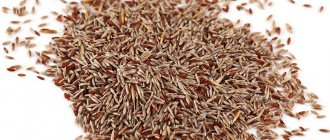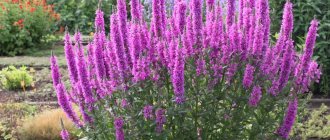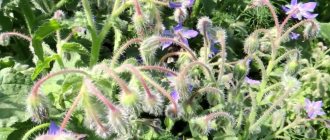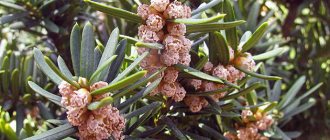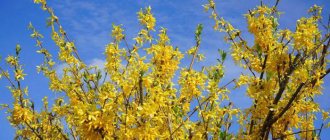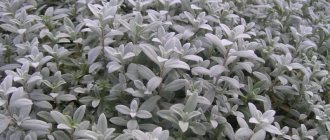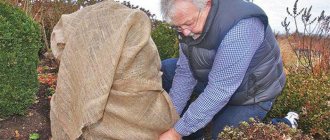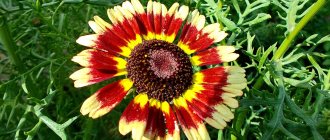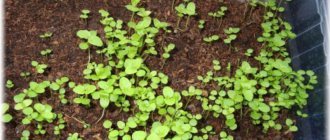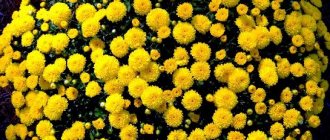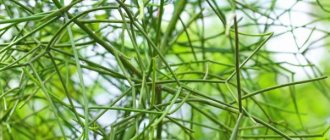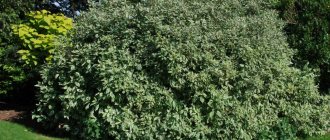Description of the plant
Pampas grass or cortaderia dioica (from the Latin Cortaderia selloana) is a perennial shrub plant native to South America, mainly in the steppes. Ornamental grass has lush inflorescences - fluffy, spectacular.
This majestic perennial grass, native to Argentina and southern Brazil, grows to a height of 2 meters in our conditions! The plant requires special growing conditions and grows in warm and cold regions. Cortaderia grows well in moist soil and can often be seen on the seashore or ocean.
Cortaderia can be planted in gardens, pots, as a decorative element of houses and public spaces. Plants look great, for example, in a hotel lobby decorated in a style that matches the natural climate.
This is a dioecious species - the plant has male and female flowers, distributed among different inflorescences. Fluffy decorative panicles are female inflorescences; they are what make the perennial popular.
Cortaderia are quite tall bushes, the leaves reach a length of 2 meters. The plant resembles a natural fountain - at a certain height the leaves bend slightly.
Cortaderia leaves form dense clumps that hang over the ground, their edges are hard and have tiny, sharp teeth along the edges that can irritate the skin when touched.
The plant becomes most beautiful when summer ends and lush, fluffy panicles of inflorescences appear, reaching a length of 30-40 cm. Depending on the type of inflorescence, they remain until the end of November - early December. Much depends on weather conditions, which have been changeable in recent years.
The grass inflorescences come in different colors - white, beige, sometimes pink, and look really elegant. Pink varieties are sometimes more expensive. Regardless of color, the fluffy panicles can reach a length of 0.5 meters, making an impressive impression.
Selecting a location
Before planting grass, you need to choose a place where the plant will feel comfortable. Cortaderia loves areas lit by the sun and protected from the wind. The grass grows well surrounded by coniferous trees, near the south or southwest side of a building, a fence, in open areas, lawns, and artificial hills.
It is equally important to determine the nature of the soil in the place where the plant is supposed to be planted. In South America, where pampas grass grows, the soil is rich in minerals, particularly calcium. In this regard, it is better to plant cortaderia on fertile, moderately moist lands.
Related article:
TOP 5 most unpretentious country flowers that bloom all summer
The crop should not be placed in lowlands near water bodies, on clayey, poorly permeable soil: the grass does not tolerate stagnant water.
The most popular varieties
There are many varieties of cortaderia in the world, differing in appearance, size, color, soil requirements, and growing conditions.
The most popular varieties:
- "Weiser Fede" - blooms with white panicles.
- "Rendatleri" and "Rosea" - bloom with pink flowers, Rosea panicles are large on stems 1.2 meters long.
- "Remorino" - looks interesting, the inflorescences are slightly silvery.
- "Sunningdale Silver" - grows up to 2.5 m, the inflorescences are cream, in our climatic conditions they will not have time to develop. Sensitive to frost.
- "Silver Stripe" and "Silver Comet" - leaves with silver stripes.
- "Aureolineata" and "Splendid Star" - distinguished by golden-yellow veins of leaf blades, grow up to 1 meter.
- "Golden Fantasy" - with light spots on low shoots.
Dwarf low-growing varieties are rare; the most popular low-growing varieties are:
- "Evita" (Evita);
- "Pumila" - tolerates low temperatures well, forms low bushes (up to 45 cm).
Mini grasses with a similar name – Mini Pampas – are popular in home interiors.
Photo. Rose plume variety
Photo. Variety "Pumila"
Photo. Variety Golden Fantasy
Varieties
In addition to the Rosea variety, there are 3 more types of pink pampas cortaderia:
- Rendatleri is a much larger plant (up to 3.5 m) with brighter colored pink panicles;
- Pink fields (Highfield Pink) - an even taller representative, reaching up to 4 meters in height, with pink-silver or pink-yellowish inflorescences;
- Pink Feather - distinguished by the complex brown-pink color of the flowers.
Related article:
A few simple ways and tips on how to level a plot in your country house
In other respects, all varieties of this variety have no differences.
Growing conditions
Landing location
The key to growing pampas grass is choosing the right planting location. In an inappropriate position, it will not only not bloom, but may die and dry out. She does not like semi-shaded positions, especially completely shady ones. This ornamental grass is extremely heat-loving.
It is necessary to provide:
- high temperature,
- insolation,
- wind protection.
It is better to choose a quiet place near the wall of the house or fence.
Different varieties have completely different frost resistance, some are not very resistant to cold and are often damaged by cold winters.
Soil requirements
| Preferred soils | Soils in which cortaderia grows poorly, gets sick |
|
|
Good soil is very important for proper grass growth. If garden conditions do not meet these requirements, it is important to fertilize the soil - especially in spring and summer, before flowering.
Cortaderia should overwinter in relatively dry soil. This has a huge impact on the overwintering of the plant. Low temperatures and high humidity promote rotting of the plant roots. Even a slight drop in temperature below 0 degrees Celsius is dangerous.
It is better to build a mound for the grass using a permeable substrate with added sand - this will provide the dry conditions necessary for winter survival. You can plant grass on slopes that protect from excessive soil moisture.
Planting cuttings or dividing a bush
If you use a part of an adult bush or a cutting for planting, the cortaderia will bloom the next year after rooting in open ground. The advantage of the vegetative propagation method is that you can immediately select female plants whose flowers are distinguished by their lushness and bright colors.
Related article:
Autumn garden: 6 flowers that will bring back spring colors with their blooms
To grow pampas grass by cuttings, shoots 5-6 cm long are cut from old bushes in August-September. The lower part of the workpiece is dipped in a rooting agent for 15 minutes, after which it is ready for planting in the ground.
It is better to divide the bush in May-June. The female plant is dug up and part of the root system is separated. After this, the grass must be immediately planted in the prepared area.
Landing
When to plant?
Because the grass seedlings are in containers, they can be planted in the ground at any time during the plant's growing season - from April to September, outside the flowering season. The best planting date is spring; the bushes have the whole season ahead of them to grow normally and not freeze in the first cold weather.
It is recommended to plant grass in the spring, once the frosts have subsided.
How to plant seedlings?
Grass seedlings are planted individually in a properly prepared substrate.
Landing:
- You should dig a hole larger than the root ball of the seedling and loosen the edges. If the soil is clayey, you need to loosen it with crushed stone and sand.
- Then the soil in the pit should be enriched with humus. The excavated soil is mixed with peat or rotted manure.
- The seedling is planted and covered with soil.
- It is important to water the planted plants frequently so that they take root well. When the summer is not hot and dry, there is no need to water frequently. The plant reacts to a lack of water by curling its leaves - then you need to water it thoroughly.
Before planting, it is advisable to shorten the above-ground part of the seedling.
Preparing the pit and planting in the ground
After choosing the location of the cortaderia, it is necessary to prepare a hole for planting with a width and depth of up to 40 cm. If several plants are planned to be planted, the distance between them is planned to be at least 1.5 m.
The specifics of the procedure depend on the nature of the soil on the site. In impervious soil rich in clay, it is important to ensure that water drains away after rain or irrigation. To do this, drainage is placed at the bottom of the hole from a layer of gravel or pebbles at least 20 cm thick. The native soil can be enriched with peat, compost, sand (up to 30% of the total).
Related article:
How to properly pinch petunia
If the soil is sandy and loose, fill the dug hole with a mixture of the following ingredients:
- 10% sand;
- 20% compost;
- 20% peat;
- 50% native soil.
When the pit is ready, it is spilled with warm water. Saplings grown from seeds, shoots or a divided bush are planted in a hole and sprinkled with earth mixed with sand. After this, the grass should be watered.
Growing and care
In order for the cortaderia to bloom profusely and be healthy, it requires appropriate conditions on the site, care and special protection from low temperatures, because the frost resistance of the plant is low.
Watering
Cortaderia requires sufficient water during the growth and flowering stages. Therefore, the most important element of caring for it is regular watering.
Important! The soil should not be allowed to dry out too much in hot weather, as this is detrimental to the cortaderia. Due to lack of water, it easily fades and dries out.
But in winter the soil must be dry! Roots rot in damp soil in winter.
Fertilizer
Most ornamental grasses do not require fertilizer. Cortaderia loves feeding. To ensure optimal growth, it is worth feeding the grass with complex mineral fertilizers with a high content of phosphorus and potassium, fertilized in the spring at the beginning of the growing season. Starting in mid-summer, fertilizing with compounds with a high potassium content and a reduced dose of nitrogen begins, so as not to stimulate growth and the grass begins to prepare for winter.
The plant responds well to organic fertilizers (compost, rotted manure), which are applied in the spring.
Weeding
The second important question is to clear the plant of weeds. The perennial is very dense, so only regular plucking of weeds will give the desired result.
When weeding, you should take special care and wear appropriate clothing and protective gloves. Pampas grass has very sharp leaves. A quick, careless movement of your hand is enough to seriously cut yourself.
Trimming
Pruning should be done in the spring - only damaged, dried leaves and old inflorescences are removed. Be aware of sharp leaves that can easily injure your skin; wear gardening gloves when working.
Wintering
In the conditions prevailing in our country, it is necessary to protect the grass from the first frost. You can take the grass to a cool, bright room for the winter, then return it to the ground in May. However, annual excavation can damage the delicate root system. You can plant the herb in a large pot that can easily be moved indoors for the winter.
Low temperatures combined with high air and substrate humidity cause the plant to die. In the Moscow region, it is recommended to cover the area around the grass with a 20-centimeter layer of dry leaves. In the Urals it is better to grow the plant in pots.
It is important to protect the leaves from getting wet in winter. The wintering plant must be dry.
Preparing for winter:
- The grass is tied into a sheaf. You can drive 3 wooden pegs around the bush and attach a bunch of grass between them.
- Then the leaf rosettes are covered with a dry layer of straw, leaves or sawdust 40-50 cm thick. It is better not to use film so that the plant does not rot during periods of thaw.
- The material used for coating must be dry! You can make an entire roof from a wooden box.
In the spring, depending on the weather, on a dry day the cover is removed, dry leaves are cut off at a height of 30 cm, and the litter is removed.
The grass can be successfully grown on the terrace in large containers, which are stored in bright, cool rooms in winter at temperatures from 2 to 20 ° C.
Advantages and disadvantages
The benefits of Plume rosea pampas grass include:
- very impressive appearance and unrivaled decorative effect among cereals due to the original coloring of the panicles;
- versatility of use in landscape gardening;
- relative ease of cultivation subject to simple rules.
The only downside can be uncontrolled growth due to self-seeding, but in temperate latitudes there is no such problem, and in the south this process must be strictly controlled. There is also the possibility that a strong root system could cause foundation failure if the plant grows next to a structure. This fact must be taken into account when planning plantings.
Related article:
Natural style garden: garden plot rejuvenation - tips for gardeners
How to propagate?
Pampas grass can be propagated in 3 ways:
- Generatively - by sowing seeds in pots in the spring, but the plants obtained from seeds will be semi-decorative male specimens.
- Propagation by cuttings.
- By dividing plants, which allows you to get a female bush.
It is best to divide overgrown grass in early spring.
Cuttings
Cuttings are carried out at the end of summer. Cuttings are collected from July 20 and germinated in a greenhouse at a temperature of 20-25 °C. Roots appear within 3 weeks. Then the rooted cuttings are grown in pots with a diameter of 12 cm in a peat substrate with a pH of 6.5.
Seeds
Cortaderia produces seeds in the form of small, oblong, light brown grains that resemble grains of rice. They develop in late autumn from small flowers. For sowing, it is recommended to use only large dry seeds without traces of mold or discoloration. Only female specimens produce seeds.
In order for cortaderia seeds to germinate abundantly and the seedlings to have the required growth vigor, you need to use seeds from trusted sources.
Planting pampas grass seeds is done at home. Obtaining seeds after flowering is not a big problem, but the seeds require special storage, which is not always possible.
The optimal time for sowing cortaderia is the end of March, April, beginning of May.
How to plant and grow cortaderia seedlings from seeds:
- Seeds can be sown in boxes, containers in a special substrate for seeds or a mixture of peat, sand and compost.
- The crops are covered with film and placed near the battery.
- At a temperature of 20-22 °C, grass seeds germinate in 14-24 days. During the germination period, the soil should be regularly watered using the drip method, spraying, periodically remove the film, and ventilate.
- Seedlings with 3-5 true leaves can be transplanted into separate pots.
At the end of spring, after frosts, seedlings are planted in the ground. But it is better in the fall, before the first frost, to bring the young cortaderia into a cool room, protected from temperature changes below 3 °C. In the second half of May next year, the grown seedlings are transplanted into flower beds.
By growing cortaderia from seeds at home, you can usually get seedlings of a male plant. They are beautiful, but not as majestic as women's. Therefore, many gardeners refuse to sow grass with seeds.
When buying a seedling, it is recommended to check that it is in good condition and not damaged. If damage is noticed, it is better to refuse and choose another plant.
Propagation of pampas grass
Cortaderia is propagated in several ways.
Most often gardeners propagate the plant:
- seeds;
- dividing the bush.
When pampas grass is propagated by seeds, planting material is collected at the end of autumn, when the seeds are fully ripe. The seeds have a very high germination rate. Planting pampas grass with seeds is carried out in early spring in the ground. The first shoots appear after 10-15 days at positive temperatures. When growing a plant by sowing seeds, the flowering period begins in the second year.
Dividing the bush is an easier way. Young shrubs develop well and bloom in the year of planting. The division of the mother plant is carried out at the end of winter. Planting is carried out in fertile, well-permeable soil.
Before planting, you should prepare the planting hole. If you plan to plant several bushes, then the distance between them should be more than one and a half meters. A drainage layer of pebbles or gravel should be poured into the bottom of the planting hole and organic fertilizer, humus or peat should be added. The plant is carefully planted in the hole and watered abundantly.
How to use in the garden and at home?
Cortaderia can be grown in gardens in different ways:
- as a single plant, in the central part of the garden, lawn;
- near ponds, flower beds;
- in a group with other herbs.
The cortaderia looks beautiful against the background of dark walls and other bushes.
If there is a lot of space, you can use grass to create a hedge that divides the garden into sections. This tall plant always sways, bringing movement to the garden. The grass helps preserve biodiversity and provides shelter for small insects in winter. In spring, birds love to take her feathers, using them as nesting material.
In a minimalist garden or geometric flower bed, grass softens hard contours and gives a pleasing appearance.
She looks good surrounded by:
- plants of similar shape - miscanthus, bamboo;
- combined with abundantly flowering asters;
- echinacea;
- next to the yucca;
- daylilies;
- Japanese anemones.
Cortaderia is a wonderful decoration not only for the garden, but also for the home. Her dried feathers look beautiful in vases. Grass inflorescences are a valuable material for bouquets and dry arrangements. Despite its grandeur, this plant option is perfect for interiors in minimalist and boho styles and is an element that transforms the interior in an interesting way.
Diseases and pests
American Cortaderia is quite disease resistant. But too much moisture can cause root rot. The disease can be recognized on the stems, becoming unstable and soft. The plant also decreases in density, the stems fold and the density of the stems decreases. The only help is to dig the root ball out of the ground, cut off the rotting roots and set the plant aside for a few hours to dry. After this, transplant to a dry place or pot. For the next two to three weeks after transplanting, the plants should be watered only moderately. Insect pests generally do not attack Cortaderia.
Answers to popular questions
- When does the cortaderia bloom? The plant produces flowers from September. When weather conditions change, flowering begins earlier. Typically flowering occurs between September and November.
- When does Cortaderia send out its shoots after winter? Regrowth after winter depends on the type, condition, and weather conditions. Usually this is the period of early spring - the border of March-April.
- How fast does grass grow? Cortaderia grows relatively quickly. In one season it can reach a maximum height of up to 2 meters of leaves and half a meter of inflorescences. The exception is miniature varieties.
Cortaderia is considered a finicky herb that is difficult to grow, but if you give it time and attention, it will grow well and bloom profusely.
Tips for caring for cortaderia
In general, care for cortaderia during the season is minimal. The plant tolerates drought well, but in the absence of rain for a long time during the rooting of young turf, regular watering is necessary. For an adult plant, seasonal rainfall is sufficient.
Variety "White-alba"
Under no circumstances should the soil be wet, since excess water leads to rotting of the roots and inevitable death of the plant. Increased soil moisture in frosts is especially dangerous, when the root system is most susceptible to the development of rot.
Cortaderia is not susceptible to diseases and pests. Its biggest enemy is moisture in the root zone. However, you can counteract this by choosing the right planting location and protecting your plants from moisture during the winter. Pests can be attacked by aphids, which provoke the development of sooty fungus.
